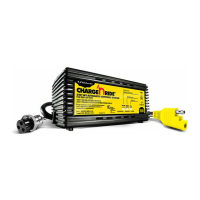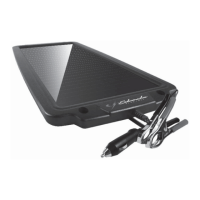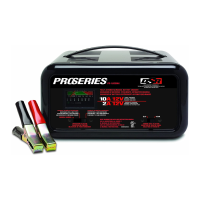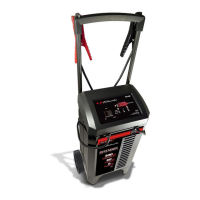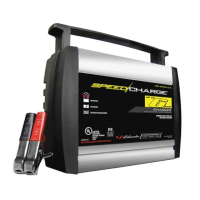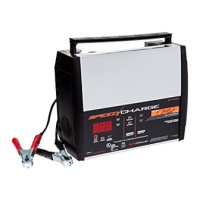Do you have a question about the Schumacher MC-1 and is the answer not in the manual?
Initial checks before using the charger and battery compatibility.
Proper handling of charger attachments, cords, and plugs.
Guidelines for operating with damaged equipment and avoiding disassembly.
Steps to prevent electric shock and proper use of extension cords.
Safe charging environment, ventilation, and temperature considerations.
Precautions for handling battery acid and placing batteries/chargers.
Safety warning about touching battery clips together.
Important safety warning regarding charger heat and ventilation needs.
Safety and steps for charging a battery while installed in a vehicle.
Correctly connecting charger clips for negative/positive grounded vehicles.
Setting amperage, completing charge, and storing the charger.
Preparing to charge a battery removed from a vehicle.
Steps for safely connecting charger clips when battery is out of vehicle.
Completing the charging process and storing the charger safely.
Explanation of model-specific switches for voltage and charge rates.
How to use the 12-hour timer to prevent battery overcharging.
Information on the self-resetting circuit breaker and troubleshooting persistent clicking.
Details on conventional/low maintenance batteries, including water addition.
Characteristics of maintenance-free batteries, which typically do not need water.
Information on deep cycle batteries, their uses, and identification.
Ensuring the electrolyte level is correct before charging.
Setting switches and timers to the off or lowest charge rate.
Connecting the charger to the AC outlet and referencing vehicle/out-of-vehicle procedures.
Setting the charge position and the need for manual monitoring.
Determining recharge time based on battery's depleted ampere hours (AH's).
Using hydrometer readings and bubbling to identify a fully charged battery.
Interpreting the meter reading as an indicator of charge status.
Connecting the charger to the battery for engine start assistance.
Setting the charger controls to the appropriate position for engine start.
Steps for using the charger to assist in starting an engine.
Precautions for charger placement, ventilation, and avoiding battery acid damage.
Details of the limited warranty, its coverage, and non-transferability.
Exclusions of implied warranties and limitations on liability.
Explanation of the percent of charge scale and its usage.
How the ammeter indicates charger amp draw and output ratings.
Interpreting meter readings for charge status and variations.
Instructions for using the meter to test battery condition on Model SE 60.
Procedure for checking the vehicle's charging system using the meter.
Mandatory eye and body protection when working with lead-acid batteries.
Ensuring someone is nearby for assistance during battery work.
Procedures for handling battery acid contact and first aid.
Warning to remove metal items to prevent burns from short circuits.
Caution against dropping tools on battery to prevent sparks or explosions.
Importance of ventilation and avoiding sparks near batteries.
Grounding the charger to reduce electric shock risk.
Using grounded plugs and adapters for safe electrical connections.
Guidelines and warnings for using adapters and ensuring proper grounding.
Ensuring the battery and charger voltages match before charging.
Instructions for cleaning battery terminals safely.
Adding distilled water to battery cells as per manufacturer instructions.
Following specific precautions from the battery manufacturer.
Ensuring adequate ventilation around the battery during charging.
Safe procedure for removing a battery from a vehicle for charging.
Special instructions for charging marine (boat) batteries.
Initial checks before using the charger and battery compatibility.
Proper handling of charger attachments, cords, and plugs.
Guidelines for operating with damaged equipment and avoiding disassembly.
Steps to prevent electric shock and proper use of extension cords.
Safe charging environment, ventilation, and temperature considerations.
Precautions for handling battery acid and placing batteries/chargers.
Safety warning about touching battery clips together.
Important safety warning regarding charger heat and ventilation needs.
Safety and steps for charging a battery while installed in a vehicle.
Correctly connecting charger clips for negative/positive grounded vehicles.
Setting amperage, completing charge, and storing the charger.
Preparing to charge a battery removed from a vehicle.
Steps for safely connecting charger clips when battery is out of vehicle.
Completing the charging process and storing the charger safely.
Explanation of model-specific switches for voltage and charge rates.
How to use the 12-hour timer to prevent battery overcharging.
Information on the self-resetting circuit breaker and troubleshooting persistent clicking.
Details on conventional/low maintenance batteries, including water addition.
Characteristics of maintenance-free batteries, which typically do not need water.
Information on deep cycle batteries, their uses, and identification.
Ensuring the electrolyte level is correct before charging.
Setting switches and timers to the off or lowest charge rate.
Connecting the charger to the AC outlet and referencing vehicle/out-of-vehicle procedures.
Setting the charge position and the need for manual monitoring.
Determining recharge time based on battery's depleted ampere hours (AH's).
Using hydrometer readings and bubbling to identify a fully charged battery.
Interpreting the meter reading as an indicator of charge status.
Connecting the charger to the battery for engine start assistance.
Setting the charger controls to the appropriate position for engine start.
Steps for using the charger to assist in starting an engine.
Precautions for charger placement, ventilation, and avoiding battery acid damage.
Details of the limited warranty, its coverage, and non-transferability.
Exclusions of implied warranties and limitations on liability.
Explanation of the percent of charge scale and its usage.
How the ammeter indicates charger amp draw and output ratings.
Interpreting meter readings for charge status and variations.
Instructions for using the meter to test battery condition on Model SE 60.
Procedure for checking the vehicle's charging system using the meter.
Mandatory eye and body protection when working with lead-acid batteries.
Ensuring someone is nearby for assistance during battery work.
Procedures for handling battery acid contact and first aid.
Warning to remove metal items to prevent burns from short circuits.
Caution against dropping tools on battery to prevent sparks or explosions.
Importance of ventilation and avoiding sparks near batteries.
Grounding the charger to reduce electric shock risk.
Using grounded plugs and adapters for safe electrical connections.
Guidelines and warnings for using adapters and ensuring proper grounding.
Ensuring the battery and charger voltages match before charging.
Instructions for cleaning battery terminals safely.
Adding distilled water to battery cells as per manufacturer instructions.
Following specific precautions from the battery manufacturer.
Ensuring adequate ventilation around the battery during charging.
Safe procedure for removing a battery from a vehicle for charging.
Special instructions for charging marine (boat) batteries.
| Brand | Schumacher |
|---|---|
| Model | MC-1 |
| Category | Battery Charger |
| Language | English |

